| QUESTION: Why did you develop the Caliber Smart Electrical System™ in the first place? |
| ANSWER: Historically, the average DC power draw was less than 100 amp-hours per average day of usage. Currently, with the plethora of navigational electronics and convenience appliances that make cruising safer and more pleasurable, that figure has doubled to 200 amp-hours. Today’s sailor needs a more sophisticated system to handle these additional loads. |
|
CALIBER SMART ELECTRICAL SYSTEM™ |
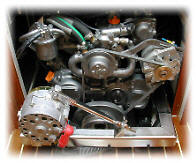 For increased performance in a marine electrical system, adding additional
batteries is not a solution. For heavy duty marine purposes, there needs to
be a different solution. A system that gives you all the
power you need, and more importantly provides that power safely and
reliably. A system that employs the latest in marine electronics technology.
A more sophisticated, intelligent one--The Caliber Smart Electrical System™.
For increased performance in a marine electrical system, adding additional
batteries is not a solution. For heavy duty marine purposes, there needs to
be a different solution. A system that gives you all the
power you need, and more importantly provides that power safely and
reliably. A system that employs the latest in marine electronics technology.
A more sophisticated, intelligent one--The Caliber Smart Electrical System™.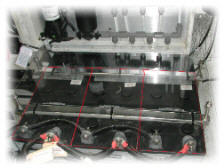 At the core, large deep cycle batteries are installed as standard equipment.
The SEries models come with a pair of high acceptance deep-cycle 200 amp AGM
(Absorbed Glass Mat) marine batteries (three in the 47LRC SEries model).
These are large batteries which are intelligently located for accessibility.
Even more convenient, adding an optional battery is a breeze. These
powerhouses require specialized charging and monitors.
At the core, large deep cycle batteries are installed as standard equipment.
The SEries models come with a pair of high acceptance deep-cycle 200 amp AGM
(Absorbed Glass Mat) marine batteries (three in the 47LRC SEries model).
These are large batteries which are intelligently located for accessibility.
Even more convenient, adding an optional battery is a breeze. These
powerhouses require specialized charging and monitors.
 So
theimportant step, is the removal of the standard automobile alternator that
comes with most engines is replace with a high-output, small frame
alternator. This alternator is capable of producing 110 amps of charging
power. This high output alternator is simply not enough to insure the
batteries get topped off properly. So
theimportant step, is the removal of the standard automobile alternator that
comes with most engines is replace with a high-output, small frame
alternator. This alternator is capable of producing 110 amps of charging
power. This high output alternator is simply not enough to insure the
batteries get topped off properly. 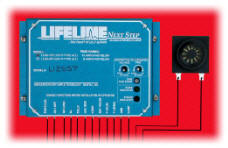 It’s important to make the high output alternator work efficiently and
safely with the deep-cycle batteries.In the Smart Electrical System™,
there is a specialized "smart regulator." It controls the charging
power to the batteries in a sophisticated step sequence regulated not only
by the voltage, but temperature too- criteria which are monitored for the
optimal charging sequence. Should there be a malfunction in the system, it
would be indicated by an error lamp and associated audio buzzer which is
included as standard. It’s a valuable safety feature on a yacht that depends
upon reliable battery power.
It’s important to make the high output alternator work efficiently and
safely with the deep-cycle batteries.In the Smart Electrical System™,
there is a specialized "smart regulator." It controls the charging
power to the batteries in a sophisticated step sequence regulated not only
by the voltage, but temperature too- criteria which are monitored for the
optimal charging sequence. Should there be a malfunction in the system, it
would be indicated by an error lamp and associated audio buzzer which is
included as standard. It’s a valuable safety feature on a yacht that depends
upon reliable battery power.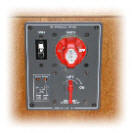 Another important built-in safety feature- the starting battery is isolated
from the house batteries yet no manually switching is required after
starting the engine to charge all batteries. Still, in the event that the
starter battery fails, there is an emergency parallel switch in the system
that makes it simple to transfer the power from the house batteries to start
the engine.
Another important built-in safety feature- the starting battery is isolated
from the house batteries yet no manually switching is required after
starting the engine to charge all batteries. Still, in the event that the
starter battery fails, there is an emergency parallel switch in the system
that makes it simple to transfer the power from the house batteries to start
the engine. 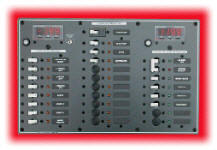 The entire electrical circuit of the yacht is protected with a circuit
protection device (CPD). Every circuit has to go through this main CPD. To
help insure this remains so for additional equipment, there are additional
positive and negative distribution posts. These posts are future attachment
points for electronics. For further safety, a manual emergency cut-off
switch is installed that is capable of shutting down the entire DC house
battery system quickly.
The entire electrical circuit of the yacht is protected with a circuit
protection device (CPD). Every circuit has to go through this main CPD. To
help insure this remains so for additional equipment, there are additional
positive and negative distribution posts. These posts are future attachment
points for electronics. For further safety, a manual emergency cut-off
switch is installed that is capable of shutting down the entire DC house
battery system quickly.The Caliber Smart Electrical System™, Caliber continues to lead the way with well-engineered safety features.
|
| From Modern Cruising Under Sail by Don Dodds |
| “The engine alternator is the next most common source of power for the batteries. Almost all engines come with alternators. The bad news is that they were designed for truck or automobile use. Truks and automobiles have rapid-draw-down, high-power-output batteries; therefore, their alternators and generators are designed to put back that kind of power, by supplying a large current load for only a short time and then substantially reducing the current output. This is a good idea for the average car battery but a poor one for boat batteries. If you have one of these alternators it should be modified to bypass this regulator system, or replaced with a good marine alternator.” |